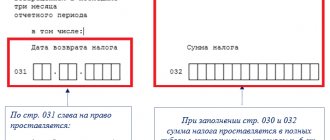The declaration form for the single agricultural tax has changed
The Federal Tax Service of Russia, by order No. ED-7-3/ [email protected] dated December 18, 2020, approved the updated tax return for the unified agricultural tax (USAT).
The order was registered with the Ministry of Justice and officially published on January 29, 2021, but the updated form should be applied starting with reporting for 2022, despite the fact that the order will come into force only two months later, at the very end of the reporting campaign for the Unified Agricultural Tax. The OKVED code was removed from the title page of the declaration. To justify the preferential tax rate established by the regions of the Russian Federation, a new line has been added in which the benefit code should be indicated, according to the same principle as in the property tax declaration. It is determined that the line code 046 indicates the number or letter designation of the corresponding structural unit (article, part, clause, subclause, paragraph, other) of the law of the subject of the Russian Federation, which, on the basis of clause 2 of Article 346.8 of the Tax Code of the Russian Federation, established a lower tax rate ranging from 0 until 6%. The barcode of the tax return for the Unified National Economy for 2022, which is placed on top of each sheet, has changed.
The instructions for the updated declaration for the Unified Agricultural Tax indicate that for each indicated structural unit (position) there are 4 fields that are filled in from left to right. If the law details do not consist of four characters, zeros are placed in the free fields on the left. For example, as indicated in the instructions, if we are talking about a benefit established by subclause 15.1 of clause 3 of Article 2 of the law of a subject of the Russian Federation, then in line 046 we indicate 000020003151.
Conditions for using the Unified Agricultural Tax
The single agricultural tax, like almost all other types of taxes, requires compliance with a number of parameters. In particular:
- In order for the right to use the unified agricultural system not to be lost, it is necessary that the share of profit from the above activities be at least 70% of the total income of the enterprise or individual entrepreneur. If there is no profit from agricultural work in any period, the tax service may refuse to apply the agricultural tax;
- if an enterprise or individual entrepreneur is engaged in fishing, then they must meet the following conditions: the share of income from fishing, growing, raising, breeding fish and selling fish products must be at least 70% of the total profit;
- fishing activities should be carried out only on those vessels that belong to an organization or individual entrepreneur under charter agreements or ownership rights;
- the number of hired personnel should not exceed 300 people.
Fiscal reporting form
The report has a standardized code - KND 1151059. The latest changes to the form were introduced in 2022 and will come into force on March 29, 2021, when the deadline for submitting the Unified National Economy Declaration for 2022 for individual entrepreneurs (peasant farms) and legal entities has already come to an end (until March 30, 2021).
IMPORTANT!
It is not necessary to use the new declaration form when preparing reports. The Federal Tax Service has declared it recommended and accepts reports on both the old and new forms. This is stated in the letter of the Federal Tax Service No. SD-4-3 / [email protected] dated 02.12.2021.
It is unacceptable to use other forms or outdated forms to submit reports. Before sending the declaration, be sure to check the relevance of the document, otherwise the Federal Tax Service will not accept the reporting and impose a fine.
Responsibility for late submission of the Unified Agricultural Tax declaration
For failure to submit a return on time, the company or individual entrepreneur will most likely be fined - 5% of the amount of unpaid tax for each month of delay. A maximum fine threshold has been established - in total it cannot exceed 30% of the arrears, and its minimum amount is 1000 rubles. Having paid the tax on time, but being late in submitting the reports, the taxpayer will also be punished - a minimum fine of 1,000 rubles. (Clause 1 of Article 119 of the Tax Code of the Russian Federation).
In addition, the Federal Tax Service has been given the right to block the accounts of an enterprise if it has not submitted a declaration within 10 days from the due date.
The decision to suspend settlement operations is made by the head of the territorial body of the Federal Tax Service on the basis of clause 3 of Art. 76 Tax Code of the Russian Federation. You can find more complete information on the topic in ConsultantPlus. Free trial access to the system for 2 days.
Who reports on the Unified Agricultural Tax?
All categories of single agricultural tax payers are required to submit a reporting declaration to the Federal Tax Service. These include commodity producers of agricultural products, not only organizations, but also individual entrepreneurs and entities that provide services in the field of crop and livestock production for agricultural producers.
Please note that in accordance with clause 2.1 of Art. 346.2 of the Tax Code of the Russian Federation, fishing organizations and merchants who fish aquatic biological resources are also recognized as payers of the Unified Agricultural Tax.
Firms that carry out only primary or secondary processing of agricultural products are not entitled to apply the Unified Agricultural Tax. Also, budgetary organizations, manufacturers of excisable goods and participants in the gambling business do not have the right to switch to agricultural tax.
ConsultantPlus experts looked at how to deal with property tax under the Unified Agricultural Tax. Use these instructions for free.
Combining the Unified Agricultural Tax with other tax regimes
Organizations cannot combine unified agricultural tax with another regime. Individual entrepreneurs have the right to work for Unified Agricultural Tax and PSN, but they must keep separate records of income and expenses. When combining regimes, the total income for determining the share from the sale of agricultural products will be at least 70% for all regimes. Unified agricultural taxation is not combined with the simplified taxation system and OSNO modes.
Thus, we can conclude that the Unified Agricultural Tax is a gentle special regime, and if an agricultural producer (or fishing organization) can meet all the specified requirements, then the tax burden for them will be minimal.
Due dates
The reporting period for the Unified Agricultural Tax is a calendar year. Consequently, all payers are required to report to the Federal Tax Service on the results of the reporting year, and the deadline for submitting the declaration under the Unified National Tax Service in 2022 is no later than March 31, 2022. If the day of submission falls on a weekend or holiday, then the deadlines are postponed; in this case, you should report on the first working day. But 03/30/2021 is a normal working environment, no transfers are provided.
IMPORTANT!
If an entrepreneur or organization has ceased activities subject to the Unified Agricultural Tax, then they will have to report to the inspection much earlier. The deadline for filing declaration 1151059 is until the 25th day of the month following the month in which the activity was ceased.
How to switch to Unified Agricultural Tax
The transition to paying agricultural tax is voluntary and is possible both when registering a business entity, and if an LLC or individual entrepreneur is already operating under some kind of regime. The notification is submitted to the registering tax authority in form No. 26.1-1.
- Newly registered individual entrepreneurs and legal entities must submit a notification within 30 days after registration to switch to the Unified Agricultural Tax.
- Already operating business entities can submit a notification no later than December 31 of the current year in order to switch to paying agricultural tax from the beginning of the new year. At the same time, they must indicate in the notification data on the share of income from the sale of agricultural products or fishing catch. This share must be at least 70% of total income.
Methods for submitting a report on the Unified Agricultural Tax
Report to the Federal Tax Service in one of three ways:
- Personal inspection visit. The report is submitted on paper. The declaration is submitted by the manager or an authorized representative. Be sure to take 2 copies of the report with you (one will remain with the Federal Tax Service, and the second, with the controller’s mark, will be kept in the organization). Also take a passport, power of attorney and other documents certifying the applicant’s authority.
- Sending by mail. The declaration form is sent to the Federal Tax Service by post. The sending option is important: use registered mail with a list of attachments. It is not prohibited to send the reports by simple letter, but in this case the taxpayer will not have any evidence of the fact of sending, and the list of attachments is a documentary confirmation of the submission of the reports when resolving disputes with the inspectorate.
- Electronic reporting. It is possible to fill out the Unified National Tax Declaration online for free and submit it through the taxpayer’s personal account or via secure communication channels. The declaration is generated electronically. The report is certified with an enhanced digital signature. Be sure to receive confirmation from the Federal Tax Service that the report has been accepted.
They fill out the reporting document using specialized accounting programs or use the Internet resources of the Federal Tax Service. Some services and programs charge fees for providing services.
Advantages and disadvantages of Unified Agricultural Tax
The use of a single agricultural tax has its advantages :
- legal entities are exempt from paying a number of taxes, incl. VAT, income tax, property tax, etc.;
- individual entrepreneurs on the Unified Agricultural Tax may not pay personal income tax (but only in cases where there is no income eligible for taxation at special rates) and personal property tax on property used for commercial activities;
- the possibility of combining the Unified Agricultural Tax with other tax regimes: UTII (for legal entities) and UTII and PTS (for individual entrepreneurs). When combining tax systems, it is necessary to maintain separate accounting and tax records for them;
- no need to pay the minimum tax in case of losses, as well as the possibility of transferring incurred losses to future tax periods;
- The transition to the Unified Agricultural Tax is of a notification nature.
In addition, the most important positive side of the Unified Agricultural Tax is simple accounting and reporting, as well as two-time payment of tax based on the results of the annual tax period (in the middle and end of the year) and one-time reporting.
At the same time, the agricultural tax also has some disadvantages :
- the share of profitability from activities related to agricultural work must be at least 70% of the total profit;
- a list of expenses that can reduce the tax base less than under the general tax system;
- cash method of income recognition;
- inability to deduct VAT on purchased goods, which, in turn, leads to increased costs.
Rules for preparing a report on Unified Agricultural Tax
Fill out the declaration taking into account the standard rules for preparing fiscal reporting. Let us recall the main recommendations:
- Double-sided printing and binding pages together is prohibited;
- corrections are unacceptable, corrective means cannot be used;
- text values are entered in capital block letters;
- if there is no data, put a dash;
- filling out fields and lines starts from the first left cell;
- numerical indicators are indicated in full rubles, taking into account rounding.
IMPORTANT!
Information on accrued and paid amounts of fines and penalties under the Unified Agricultural Tax is not reflected in the declaration. These amounts do not apply to tax calculations.
Instructions for filling out the declaration
Detailed instructions were approved by Federal Tax Service Order No. ММВ-7-3/ [email protected] dated 07/28/2014 in an updated version.
Title page
INN and KPP: indicate the taxpayer codes. If the report is prepared by an individual entrepreneur, then do not fill out the checkpoint code, but put dashes.
Tax period: enter code “34” if you are submitting a report for a full calendar year. If the activity subject to the Unified Agricultural Tax has been discontinued, then enter code “96”. When switching to another taxation system - code “95”.
Reporting year: enter the year for which you are reporting.
Federal Tax Service code: enter the four-digit code of the receiving inspection.
Taxpayer codes of the Unified Agricultural Tax at the place of registration:
- 120 - the declaration for peasant farms and individual entrepreneurs is indicated;
- 214 - for Russian organizations;
- 213 - for the largest taxpayers;
- 331 - for foreign companies.
Next, indicate the full name of the taxpayer or full name of the entrepreneur. Enter the OKVED code. Enter your phone number.
Fill out information about the person who signed the report only for the organization. Individual entrepreneurs put dashes in the corresponding section of the title page.
Section 1
Lines 001 and 003 are OKTMO codes that identify the municipalities in which taxpayers are registered.
In line 002 we indicate the amount of the advance for the first half of the year.
Line 004 is the amount of tax to be transferred to the budget.
Line 005 is filled in only if the advance payment exceeds the amount of the annual tax.
Section 2
We calculate the tax payable to the budget. We indicate in the appropriate lines of the form:
- income received by the taxpayer;
- the amount of expenses incurred in the reporting period (what can be included in the expenses in the Unified National Economy Tax return, determined by the norms of the Tax Code of the Russian Federation);
- tax base (the difference between income and expenses);
- the amount of losses that were received in previous periods;
- tax rate applicable in the region;
- calculated tax amount.
Section 2.1
Fill out this section only if the taxpayer has incurred losses. The company has the right to take losses into account when calculating the tax base for 10 years. The 2022 loss can be taken into account up to and including 2030.
Section 3
Disclose information about the targeted funding received during the reporting period. If the taxpayer did not receive targeted property, charitable contributions, grants or other targeted investments, then Section 3 does not need to be completed.
Check the report, sign and indicate the date of preparation.
Title page
On the title page of the declaration, indicate:
- TIN and KPP of the organization (fill in the cells allocated for the TIN from left to right; in the two cells that remain free, put dashes);
- adjustment number (for the primary declaration – “0—”, for the updated declaration – “1—”, “2—”, etc.);
- tax period code in accordance with Appendix 1 to the Procedure approved by order of the Federal Tax Service of Russia dated July 28, 2014 No. ММВ-7-3/384 (for example, code 34 is entered in all cases when the organization, after the end of the tax period (year), continues to apply the special regime in form of Unified Agricultural Tax);
- the reporting year for which the declaration is being submitted;
- code of the tax office to which the declaration is submitted (according to the document on tax registration of the organization);
- code of the type of place for submitting the declaration in accordance with Appendix 3 to the Procedure approved by Order of the Federal Tax Service of Russia dated July 28, 2014 No. ММВ-7-3/384 (for example, when submitting a declaration at the location of a Russian organization - 214);
- full name of the organization;
- code of the type of economic activity according to OKVED 2 or OKVED (Order of Rosstandart dated September 30, 2014 No. 1261-st);
- code of the form of reorganization or liquidation in accordance with Appendix 2 to the Procedure approved by order of the Federal Tax Service of Russia dated July 28, 2014 No. ММВ-7-3/384, TIN and KPP of the reorganized organization (only in case of reorganization or liquidation);
- contact phone number of the organization;
- the number of pages on which the declaration is drawn up;
- the number of sheets of supporting documents (their copies) attached to the declaration, including documents (their copies) confirming the authority of the organization’s representative (if the declaration is submitted through an authorized representative).
The title page must contain the date the declaration was filled out, as well as the signature of the person certifying the accuracy and completeness of the information specified in the declaration.
If this is the head of the organization, indicate his last name, first name and patronymic, personal signature certified by the seal of the organization. In this case, in the section of the title page “I confirm the accuracy and completeness of the information specified in this declaration”, “1” is entered.
If this is a representative of an organization, in the section of the title page “I confirm the accuracy and completeness of the information specified in this declaration”, “2” is entered:
- employee or third-party citizen - the surname, name and patronymic of the representative are indicated, his personal signature is affixed, and the name of the document confirming his authority is indicated (for example, a power of attorney on behalf of the organization);
- third-party organization – indicate the name of the representative organization; surname, name and patronymic of the employee who is authorized to certify the declaration on her behalf, his personal signature is affixed, certified by the seal of the representative organization, and documents confirming the authority of the representative organization (for example, an agreement) are indicated.
This is stated in Section III of the Procedure, approved by order of the Federal Tax Service of Russia dated July 28, 2014 No. ММВ-7-3/384.






